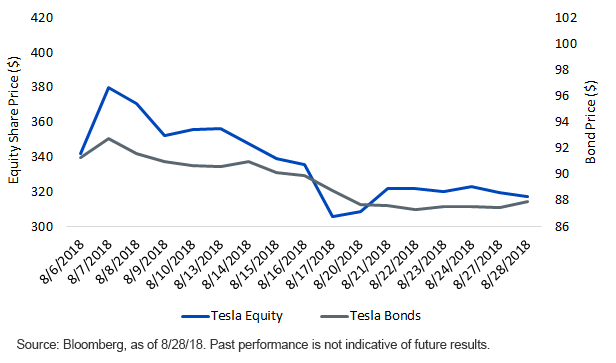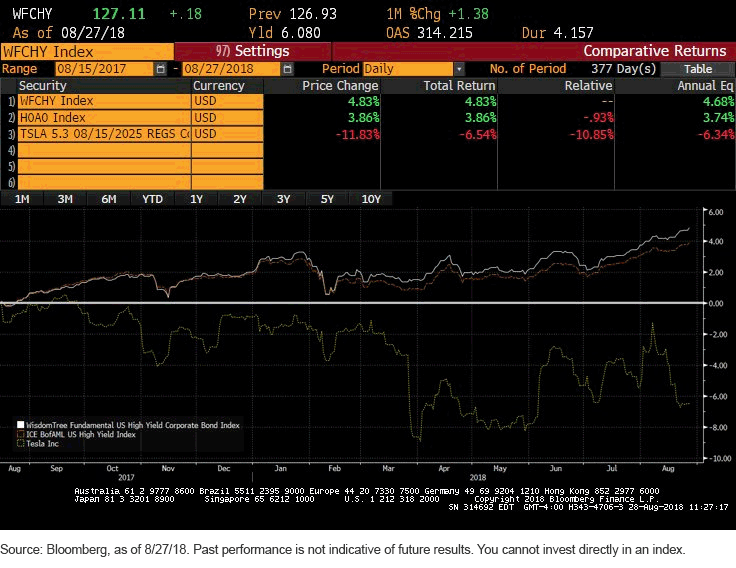Tesla Debt: One Year Later


In what feels like an eternity, Tesla’s1 first salvo of fixed-term debt was issued just over one year ago on August 15, 2017. On August 7, 2018, Tesla CEO Elon Musk cryptically announced via Twitter that he is considering taking Tesla private at $420 per share. On August 24, 2018, Tesla announced in a blog post that the company would be remaining public. In an earlier post, we highlighted why we believe high-yield investors should avoid Tesla debt based on our view of company fundamentals. Our conclusion is based on the rate at which Tesla burns cash, resulting in significantly negative free cash flow. In a similar vein, New York University professor Aswath Damodaran, an expert on corporate valuation, has argued that companies like Tesla should never issue debt in the first place! While the stock initially ripped higher and then fell back below the pre-management buyout (MBO) pricing, trading in fixed coupon Tesla debt could only be described as muted. Below, we seek to draw some conclusions about recent action in the bond market and what it may mean for investors going forward.
Tesla Debt & Equity
While equity investors reacted to Musk’s tweet by pushing the stock higher by close to 10%, Tesla’s bonds barely budged. Curiously, this occurred despite a change of control provision that allows investors to sell their debt back to the company at $102.
In our view, we can rationalize the muted response in the bond market in two ways: the casualness of the announcement lacked credibility despite it coming from the CEO of a publicly traded company, and bond investors were more skeptical that a technical change of control would be triggered. On this second point, Musk subsequently “clarified” that existing shareholders need not tender their shares and could instead remain invested in the new private entity. If Musk would have been able to put together a transaction that restricts a new investor from acquiring more than a 50% stake, it’s possible that existing covenants could have been avoided.
Reaction to Tesla MBO Announcement

While untested, this ambiguity primarily seems to serve as an easy way to qualify his “funding secured” representation that the Securities and Exchange Commission is investigating. Regardless, observable market prices were skeptical given the minimal details of the plan. Before suspending their coverage, Goldman Sachs had assigned a six-month fair value price of $210 or a 50% discount to Musk’s plan.2
Positioning Portfolios
While we remain on the sidelines as the Tesla story continues to evolve, we do believe that the performance of Tesla’s debt can offer valuable clues as we progress later into the credit cycle. In this instance, we believe investors should assess the underlying fundamentals of the businesses to which they’re lending.
As we show below, we believe we may be starting to see a marked divergence between lower-quality issuers and companies with stronger fundamentals such as strong free cash flow. Since the start of the year, the WisdomTree Fundamental U.S. High Yield Corporate Bond Index (WFCHY) has slowly started to pull away from its market capitalization weighted benchmark.3 Compared with Tesla’s bonds, both strategies have outperformed since Tesla issued last August.
Total Returns: WFCHY vs. High Yield vs. Tesla Debt

Conclusion
While it’s possible that Tesla can build on recent production momentum, we do not believe that Tesla’s debt is currently worth the risk. For investors seeking high levels of income while still being mindful of fundamentals, we believe the WisdomTree Fundamental U.S. High Yield Corporate Bond Fund (WFHY) could strike a more appropriate balance between risk and reward.
1For holdings of Tesla in WFHY, please click here.
2Source: Goldman Sachs, as of 8/8/18.3As represented by the ICE BofAML U.S. High Yield Master II Index (H0A0).
Important Risks Related to this Article
There are risks associated with investing, including possible loss of principal. Fixed income investments are subject to interest rate risk; their value will normally decline as interest rates rise. High-yield or “junk” bonds have lower credit ratings and involve a greater risk to principal. Fixed income investments are also subject to credit risk, the risk that the issuer of a bond will fail to pay interest and principal in a timely manner or that negative perceptions of the issuer’s ability to make such payments will cause the price of that bond to decline. While the Fund attempts to limit credit and counterparty exposure, the value of an investment in the Fund may change quickly and without warning in response to issuer or counterparty defaults and changes in the credit ratings of the Fund’s portfolio investments. Please read the Fund’s prospectus for specific details regarding the Fund’s risk profile.


